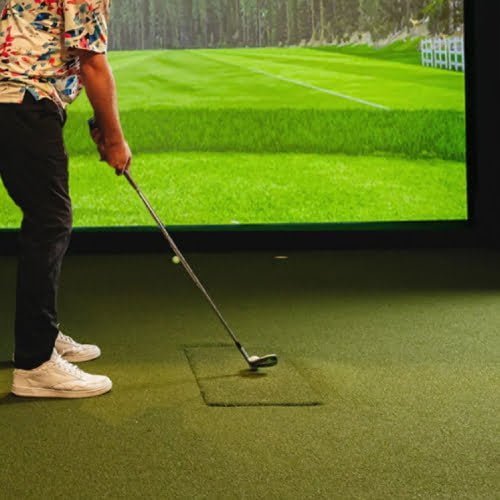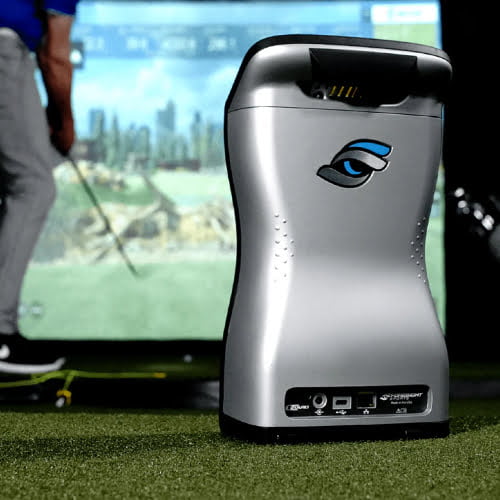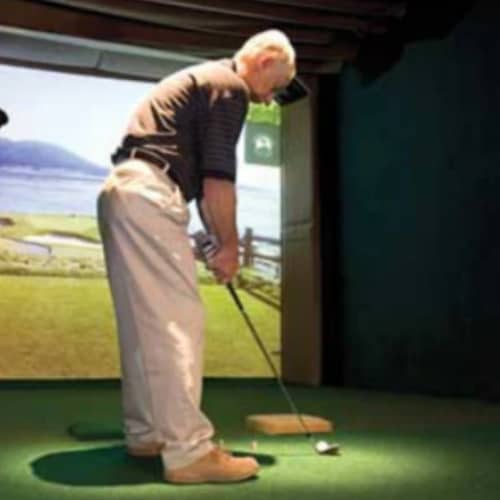Putting is an essential part of any golfer’s game. It is usually the part that can make your game or break it. According to the USGA, through research conducted by 18birdies.com, on average, golfers make 98-99 shots per round, 40 of which are putts (2.2 putts per hole). Professionals putt around 32 times each round (1.8 for each hole).
And with the rise of virtual golf as a more convenient way of practicing, you might be asking yourself how putting works on a golf simulator.
In the early days of virtual golf, putting was Achilles’ Heel for golf sims, as most systems performed poorly in that specific game aspect. With technological advancements, however, things seem to have changed drastically, and modern systems do take into consideration putting practice, with some even integrating software portions dedicated to putting practice and analysis.
In this article, we will explore how you can benefit the most from putting practice sessions on your virtual system and improve your overall game.
How Does Putting Work On A Golf Simulator?
There are two primary options for putting on a simulator: manual putting and auto-putting. Manual putting includes the player actually hitting the putt and the system tracking the ball and providing a virtual simulation of the shot.

Auto-putting, on the other hand, means the software takes care of putting for you; once you reach the green in your virtual game, the simulator automatically adds the tour average number of putts corresponding to the distance you are from the hole.
Putting on a simulator differs from outdoor putting because the simulator provides real-time feedback on the ball’s path, speed, and direction, which is not possible on a real green. Additionally, the green speed and ball movement can be adjusted based on the player’s preferences.
However, putting on a simulator takes some adjustment time; depth of field is missing, and you may not putt accurately at first. Still, with enough time to make necessary (mental and physical) adjustments, you will eventually get used to putting into a screen.
If you’re curious about how golf simulation works (in general), you can read our detailed article explaining how different parts work together, where we dive into the mechanics of golf simulators, their technology, and how they replicate the golfing experience.
Golf Simulator Putting Technology
Modern golf simulators use various sensors, high-speed cameras, and other advanced technologies to track the ball’s movement, ensuring that it mimics the real-life golfing experience as accurately as possible.
Some simulators come with state-of-the-art putting analysis software that allows players to analyze their swings and putting performance in real time. This software uses complex algorithms that can accurately determine factors such as club speed, smash factor, approach angle, and swing speed, among others.

A good example of a premium launch monitor is Flightscope’s X3, their most advanced unit to date using radar and photometric technologies for the most accurate tracking. The X3 is capable of tracking your short game (putting and chipping) and provides data such as face-to-path, face-to-target, skid distance, roll distance, etc. You also get recordings of your shots for further analysis. Another great photometric system is Foresight Sports’ GCQuad launch monitor, which can also provide valuable putting data through their optional Putting Analysis Addon.
How Does a Golf Simulator Track the Ball?
A golf simulator uses various technologies to track the ball and provide accurate feedback on its trajectory. Here are some common methods used by golf simulators to track the ball:
- Optical Sensors: Many golf simulators employ high-speed cameras or optical sensors to track the movement of the ball. These sensors capture multiple images of the ball’s position as it travels through the hitting area. By analyzing the changes in the ball’s position over time, the simulator can calculate the speed, spin, launch angle, and direction of the ball.
- Doppler Radar: Some systems use Doppler radar technology to track the ball. Doppler radar measures the frequency shift of the radar waves reflected off the moving ball. By analyzing the frequency shift, the simulator can determine the ball’s speed and direction.
- Infrared Sensors: Infrared sensors are often used to track the ball’s flight. These sensors emit an infrared beam that is interrupted when the ball passes through it. By measuring the time it takes for the ball and/or club to pass through multiple sensors, the simulator can calculate the ball’s speed, trajectory, and direction.
- Computer Vision: Advanced golf simulators may utilize computer vision techniques (employing AI) to track the ball and club. By using sophisticated algorithms and image processing, the simulator can analyze video footage of the ball’s movement and extract information about its trajectory.
It’s important to note that different golf simulators may employ a combination of these technologies or may have proprietary tracking systems. Additionally, the accuracy and precision of ball tracking can vary depending on the quality and sophistication of the simulator.
How Can a Golf Simulator Improve Your Putt?
Using a golf simulator to practice your putts has many benefits, from shaving strokes off your game to getting used to different putting scenarios. You may encounter green speed variations, different slopes, and tricky angles, simulating real-life golf situations. By practicing on a simulator, you can improve your decision-making skills and develop the confidence to handle putting scenarios when you’re playing a real round of golf.
In addition, by using technology to track your metrics and practicing in a realistic environment, you can ensure optimal performance by placing your impact screen at the right distance. For more information on impact screen distance from the wall, refer to our guide.

In addition, by using technology to track your metrics and practicing in a realistic environment, you’ll be better prepared to handle any putting situation on the course.
As mentioned earlier, you can use a real ball and experience the ball movements of a real game or try the auto putt setting where the sim takes care of the putts automatically. A separate putting green feature can also create a well-rounded short-distance game for you to practice on.
While manual putting is the best way to go, sometimes you may have software, hardware or space limitations that won’t allow you to practice putting on your indoor simulator. In such cases, auto putt can be your only choice (even if you will be practicing all game aspects, except putting).
Tips for Putting Using a Golf Simulator
Let’s go through some tips to help you benefit the most from your sim putting practice sessions.
Set a Target in The Direction You’re Hitting.
To improve your putting accuracy on a golf simulator, it’s essential to set a target in the direction you’re hitting. This helps you stay focused, enhances your accuracy, and allows the simulator to provide precise tracking of your putt.

Here’s how you can set a target in the direction you’re hitting:
- Choose a target: Start by selecting a target in the direction you’ll be hitting the ball. This can be as simple as creating a ground-level target that’s shaped like a golf hole or using a target placed within the simulator.
- Enhance your focus: Most simulators can read the initial launch of the ball; by aiming at a target, you’ll be able to focus on hitting the ball towards that specific target, enhancing your concentration and overall accuracy.
- Line up your ball: While setting up to putt, use the line on your golf ball to line up in the direction you want the ball to start. By orienting yourself in this way, you’ll have a better idea of the path the ball should take to reach the target you’ve set.
Gauge The Distance.
When putting on a golf simulator, it’s important to gauge the distance correctly to make the shot. Start by measuring the distance between the ball and the simulator screen. This can be used to determine the ratio of distance to strength required to make the putt.
Hit a test shot and observe the feedback, which will show you how the distance converts to a putt strength. This informs how far and how hard you need to hit the putt. Repeat this process several times to ensure consistency. You can also use markers to gauge distance on the simulator, so you are familiar with the distance required for specific shots.
This strategy will help you overcome the issue of lack of depth of field (mentioned earlier) and pinpoint exactly how much strength you need to achieve specific distances for your virtual putts.
Get Used to The Greens.

When using a golf simulator for putting, it is essential to get accustomed to the greens. Like real-life golf, it is crucial to understand the speed of the greens and to be able to read the grid lines used in most software systems. Spending time familiarizing yourself with the greens on your simulator will greatly benefit your putting game.
Additionally, TGC 2019, one of the most popular simulation software today, has varying speeds for each course, adding to the realism of the experience. This means that you need to be prepared to adjust your putting approach based on the specific virtual course you are playing.
Putt Like You Would on the Course
To putt like you would on the course, you need to line up your ball based on the green speed and slope on the simulator.
Start by taking practice swings to find your stroke and feel comfortable with the putter. Then, aim for the center of the cup by lining up your ball with the center of your putter face. Make sure your stance is square to the ball and that your shoulders are parallel to the target line.
It is crucial to simulate real-life golf situations when you’re practicing your putts on a simulator. The green speed and slope can vary, and to make the most out of your practice, take practice swings, line up your ball carefully, and gain the confidence to handle different putting scenarios. By practicing on a simulator, you can improve your putting skills and shave strokes off your game.
Know the Green Speed
To be successful at putting on a golf simulator, you need to know the green speed and how it affects your game. Understanding how to adjust the speed of the greens on the simulator is also crucial. Begin by using the practice mode to gain an advantage and get familiar with the greens before playing.
Knowing how to read the grid lines on the simulator is essential to gauge the green speed. This will help you adjust your putt accordingly and make the most out of every shot. Take note of the slope of each hole and use this to your advantage.
By taking the time to practice and get familiar with the greens, you will be able to read the grid lines and adapt your putting approach. This will help you improve your performance and gain an edge in any golf game.
Full Golf Simulator Vs. Putting Only Simulator
When it comes to golf simulators, there are two main options: a full simulator or a putting-only simulator. A full simulator (like HD Golf’s Ultimate Packages or Trugolf Vista 12) allows you to practice your swing, ball flight, and approach shots, while a putting-only simulator, like the ExPutt real Time Puttin Sim, is designed solely for putting practice.

A full simulator usually includes a screen, projector, launch monitor, and software package. This type of simulator is the more expensive option but provides a more realistic and comprehensive golf experience. A full simulator setup requires a dedicated space and a larger budget.
On the other hand, a putting-only simulator is more affordable and takes up less space. This type of simulator usually consists of a practice putting green and a device that tracks your putts and provides feedback on your technique. With a putting-only simulator, you can focus solely on your putting skills, including reading greens and adjusting your stroke.
Choosing between a full simulator and a putting-only simulator depends on your needs and budget. If you’re looking for a more realistic golf experience and have space and budget to spare, a full simulator may be the way to go. But if you’re mainly focused on improving your putting skills and have limited space and budget, a putting-only simulator like Exputt’s could be the perfect fit for you- and it does a great job, as it was our top pick among the best simulators we tested for putting purposes.
Final Thoughts
In conclusion, putting on a golf simulator requires the same skills and techniques as putting on a real green. The key is to have a proper setup that allows you to practice your skills and improve your game.
Putting into a simulator screen might not seem natural at first, but with dedication and constant practice, you will get used to it in no time. Your sim will provide unlimited practice time and helpful data so you can refine your putting (and overall game) technique, which will ultimately help you become a better putter and golfer on the real course.
Just make sure you pick the right setup for the purpose. If you find it hard to make a final decision, we advise you to check out our detailed reviews of the best golf simulators for putting. You will find a system that fits your needs and budget on our list.
Thanks for reading!




